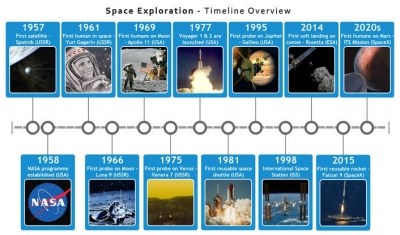
SPACE EXPLORATION
Humans have only been able to send spacecraft to explore space for about 50 years. In that time, more than 100 robotic craft have travelled into the Solar System to reveal what its planets, moons, asteroids, and comets are like. They fly by, orbit, or land on these other worlds. Humans have only been to the Moon, but aim to set foot on Mars in the future.
TIMELINE OF SPACE EXPLORATION
14 October 1957: Sputnik 1, the world’s first artificial satellite, is launched into Earth’s orbit by Russia.
3 November 1957: Laika, a Russian dog aboard Sputnik 2, becomes the first creature to orbit Earth.
2 January 1959: Russian spacecraft Luna 1 is the first to escape Earth’s gravity.
13 September 1959: Luna 2 is the first craft to land on the Moon when it crashes onto its surface.
12 April 1961: Russian Yuri Gagarin is the first person into space. His flight lasts 108 minutes.
16 June 1963: Russian Valentina Tereshkova is the first woman in space.
18 March 1965: Russian Alexei Leonov makes the first EVA (extra vehicular activity), or spacewalk.
3 February 1966: Luna 9 lands successfully on the Moon.
24 December 1968: US spacecraft Apollo 8 is the first manned mission to leave Earth’s gravity and orbit the Moon.
20 July 1969: Neil Armstrong and Buzz Aldrin of Apollo 11 are the first humans to walk on the Moon.
19 April 1971: The first space station, Salyut 1, is launched by the Russians.
3 December 1973 US craft Pioneer 10 is the first to fly by Jupiter.
29 March 1974: US craft Mariner 10 is the first to fly by Mercury.
17 July 1975: US craft Apollo 18 and Russian Soyuz 19 make the first international space rendezvous.
22 October 1975: Russian craft Venera 9 transmits the first images from the surface of Venus.
20 July 1976: US craft Viking 1 is the first to land successfully on Mars.
1 September 1979: Pioneer 11 is the first to fly by Saturn.
12 April 1981: Columbia, the first US space shuttle, is launched.
24 January 1986: US craft Voyager 2 is the first to fly by Uranus.
13 March 1986: European craft Giotto takes the first close-up look at a comet.
24 August 1989: Voyager 2 is the first craft to fly by Neptune.
24 April 1990: The Hubble Space Telescope is launched.
15 September 1990: US craft Magellan starts a three-year mapping programme of Venus.
29 October 1991: US craft Galileo makes the first flyby of an asteroid as it passes Gaspra. 13 July 1995: Galileo arrives at Jupiter and releases a probe to enter its atmosphere.
4 July 1997: US craft Mars Pathfinder and its Sojourner rover touch down on Mars.
20 November 1998: Zarya, the first module of the International Space Station (ISS), is launched.
2 November 2000: The first crew arrives to stay aboard the ISS.
12 February 2001: The NEAR craft lands on asteroid Eros.
25 December 2003: Europe’s first interplanetary craft, Mars Express, orbits Mars.
30 June 2004: US craft Cassini arrives at Saturn to study the planet and its moons. It releases Huygens to land on the moon Titan.
20 November 2005: Japanese craft Hayabusa lands on asteroid Itokawa.
4 August 2007: US craft Phoenix sets off for Mars, arriving in 2008.
18 March 2011: US Messenger spacecraft becomes the first vehicle to orbit around Mercury.
6 August 2012: US Curiosity rover lands in the Gale Crater on Mars.
6 August 2014: European spacecraft Rosetta, carrying the Lander Philae, enters orbit around Comet Churyumov-Gerasimenko.
14 July 2015: US craft New Horizons makes the first flyby of the dwarf planet Pluto.
5 July 2016: US Juno spacecraft enters orbit around Jupiter to survey the planet’s Polar Regions.
15 September 2017: Cassini ends its mission with a deliberate plunge into Saturn’s atmosphere.
Picture Credit : Google




